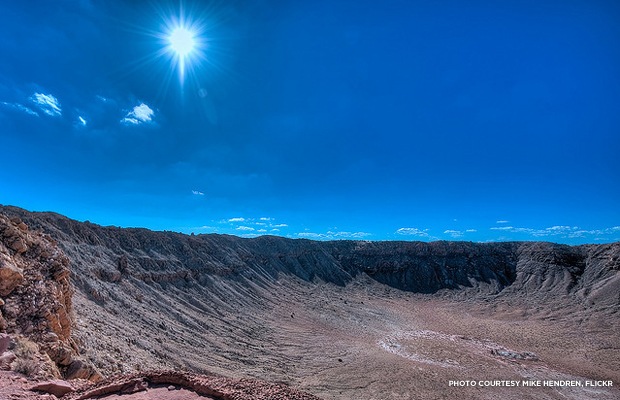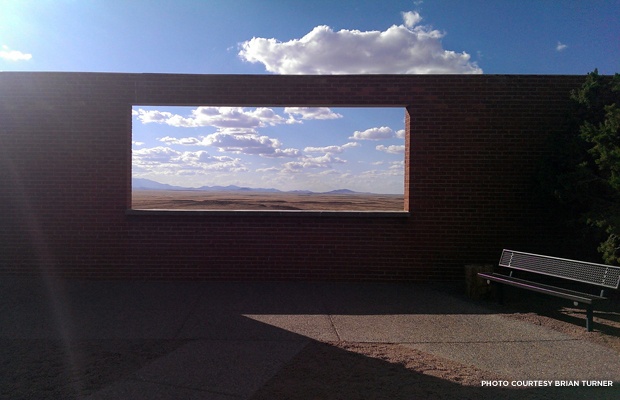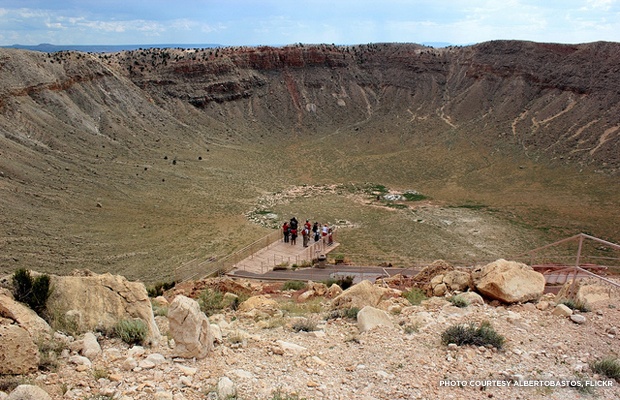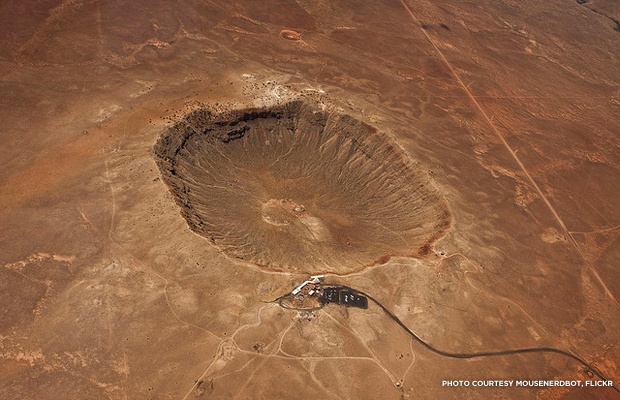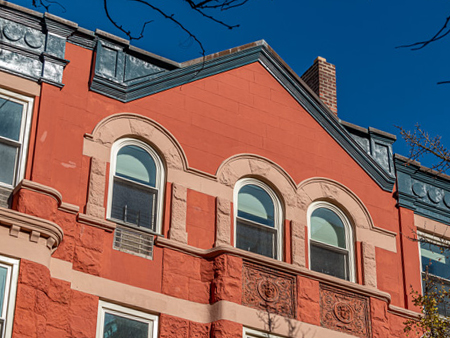Paulina Tam reports for PreservationNation Blog.
A meteor crater in Winslow, near the eastern border of Arizona.
To those who dream of going to space but haven’t been able to visit the stars, Meteor Crater Visitors Center in Winslow, Arizona, gives visitors a chance to see a piece of otherworldly history: a 550-feet deep meteorite crater created approximately 50,000 years ago.
This natural national landmark left quite an impression on astronauts training for the Apollo Missions in the 1960s, who came to the site to learn how to identify craters and collect moon rocks. Also leaving a lasting impression at the Visitors Center: a glass-less window in a brick wall that frames the wide Arizonian landscape with its bare yet striking simplicity, designed by the late American architect Philip Johnson.
Johnson also helped designed the Meteor Crater Center’s pavilion. “The Park Service was still struggling to revive itself after war during the late 1940s, when the designs were submitted for a modern building at Meteor Crater,” writes Sarah Allaback, author of Mission 66 Visitor Centers: The History of a Building Type.
“The commission went to Philip Johnson, co-organizer of the 1932 International Style exhibition at the Museum of Modern Art and, more recently, architect of the ‘glass house’ (1949) in New Caanan, Connecticut,” Allaback writes. “Johnson’s work must have seemed fittingly futuristic to his clients at Meteor Crater.”
However, over the years the site has added various extensions such as a Museum (Discovery Center) in 1956, a two-story apartment for workers in 1960, and a Retail and Food Service Building in 1962, making it unclear which parts of Johnson’s original designs still remained and whether any of them molded with any of the modern constructions.
Now renovations are approaching for the landmark, and with them come a multitude of decisions for the pavilion. A master plan for renovation maps out a construction series that will illustrate the Visitors Center’s future for the next 10 to 20 years, says Robyn Messerschmidt, Vice President of Administration at the Center. The first step would be the Center’s admissions building, where Johnson’s work is located.
“It [is] very military looking and it’s even been said it looks like a prison, so we’re trying to make it look appealing so people will come in,” says Messerschmidt. “One of the major problems that we have is that people don’t understand what we have beyond the point, and so having a more appealing entrance will get people more excited about what they’re about to see inside.”
She adds that the first phase of construction should be finished by the end of August and September. Earlier in the first phase, David Green, a scientific advisor of the Barringer Crater Company, a privately owned organization that owns the Meteor Crater, came out to make sure everything was running smoothly and to make sure they weren’t doing anything that might disturb the crater’s original integrity.
New changes will come but the old will mostly stay intact, says Messerschmidt. Guided rim tours and three-sectioned observation decks, each allowing the viewer a different view of the crater, are in place to give viewers a chance to see the crater in its entirety while protecting it from foot traffic.
A glass viewing area will enclose the Visitors Center, essentially enveloping Johnson’s work inside it too, says Messerschmidt.
Demion Clinco, a National Trust Advisor for Arizona, and Andie Zelnio, architect and board member of the Tucson Historic Preservation Foundation, believe that since the Center is privately owned and previous changes have already changed much of Johnson’s original designs, further renovations would, in effect, eliminate Johnson’s work.
“We believe [Johnson’s original design] is an important building, a forgotten treasure by one of our country’s most significant architects and Philip Johnson’s only work in the state of Arizona,” say Clinco and Zelnio in an email. “During our visit to the site in May, it appears that the plaza and portions of the Visitors Center retain aspects of Johnson’s signature work, but further scholarship is needed to determine the facts.”
As fences encase the construction zone and heavy machinery move into the landscape, Johnson’s future is left uncertain. His only view is towards the wide Arizonian desert, and only the sands of time will determine whether his work will remain.

